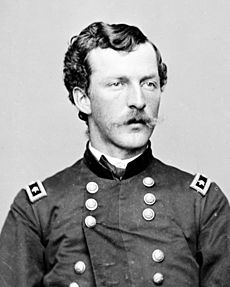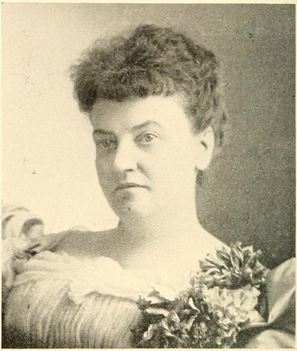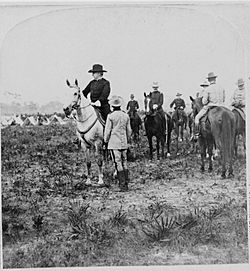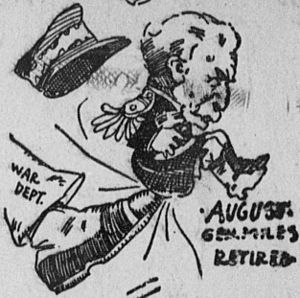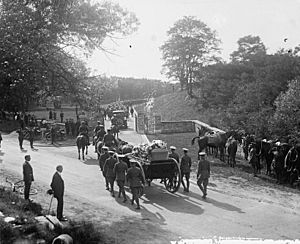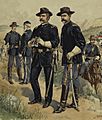Nelson A. Miles facts for kids
Quick facts for kids
Nelson A. Miles
|
|
|---|---|
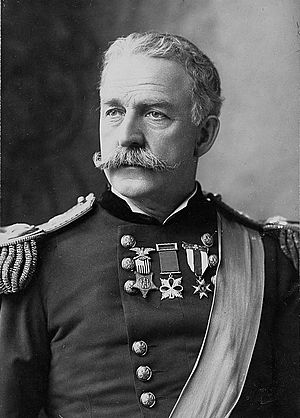
Nelson A. Miles
|
|
| Birth name | Nelson Appleton Miles |
| Born | August 8, 1839 Westminster, Massachusetts |
| Died | May 15, 1925 (aged 85) Washington, D.C. |
| Place of burial | |
| Allegiance | United States of America |
| Service/ |
United States Army Union Army |
| Years of service | 1861–1903 |
| Rank | |
| Unit | |
| Commands held | 61st New York Volunteer Infantry Regiment Military Division of the Missouri Commanding General of the United States Army |
| Battles/wars | American Civil War Indian Wars Spanish–American War |
| Awards | Medal of Honor |
| Other work | Military Governor of Puerto Rico |
| Signature |  |
Nelson Appleton Miles (born August 8, 1839 – died May 15, 1925) was an important American military general. He fought in three major wars: the American Civil War, the American Indian Wars, and the Spanish–American War. From 1895 to 1903, he was the very last Commanding General of the United States Army, a top leadership role in the army.
Contents
Early Life and Military Start
Miles was born on his family's farm in Westminster, Massachusetts. Before joining the army, he worked in Boston. He spent time studying military history and learned many important army skills and battle plans.
Serving in the Civil War
When the American Civil War began, Miles was working in a store. He joined the Union Army as a volunteer on September 9, 1861. He fought bravely in many key battles. He became a lieutenant in the 22nd Regiment Massachusetts Volunteer Infantry. Later, he was made a lieutenant colonel of the 61st New York Volunteer Infantry Regiment in May 1862. After the Battle of Antietam, he was promoted to colonel.
Miles also fought in battles like Fredericksburg and Chancellorsville. At Chancellorsville, he was shot in the neck and stomach. He was wounded four times during the war. For his brave actions at Chancellorsville, he was honored as a brigadier general in the regular army in 1867. He was also honored as a major general for his actions at the Battle of Spotsylvania Court House.
On July 23, 1892, he received the Medal of Honor for his courage at Chancellorsville. By October 1865, at just 26 years old, he was appointed a major general of volunteers. After the war, he was in charge of Fort Monroe, where former Confederate President Jefferson Davis was held. Miles had to defend himself against claims that Davis was being treated poorly.
Leading in the Indian Wars
In July 1866, Miles became a colonel in the Regular Army. In March 1869, he took command of the 5th U.S. Infantry Regiment. In June 1868, he married Mary Hoyt Sherman. She was the niece of famous generals William Tecumseh Sherman and John Sherman.
Miles played a big role in almost all of the U.S. Army's campaigns against American Indian tribes on the Great Plains. From 1874 to 1875, he helped defeat the Kiowa, Comanche, and Southern Cheyenne tribes. This happened along the Red River.
After Lt. Col. George Armstrong Custer's defeat at the Battle of the Little Bighorn, Miles led a campaign in 1876-1877. His troops forced the Lakota and their allies onto reservations. In 1877, he led his troops on a long march across Montana. They were trying to stop the Nez Perce band led by Chief Joseph during the Nez Perce War. Miles and General Oliver O. Howard often argued about who deserved credit for capturing Joseph.
While on the Yellowstone River, Miles became very skilled with the heliograph. This device uses mirrors to send messages with sunlight. In 1878, he set up a 140-mile-long line of heliographs. This line connected Fort Keogh and Fort Custer.
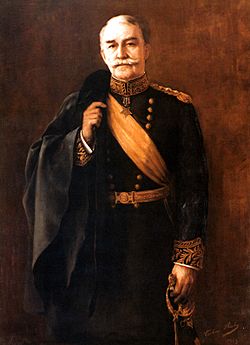
In December 1880, Miles was promoted to brigadier general in the Regular Army. He then commanded military departments in the west. In 1886, Miles took over from General George Crook in the fight against Geronimo. Geronimo was a Chiricahua Apache leader. General Crook had used many Apache scouts. Miles, however, used white troops. His troops traveled 3,000 miles tracking Geronimo through mountains without success.
Finally, First Lieutenant Charles B. Gatewood was able to negotiate Geronimo's surrender. Geronimo and his followers agreed to go to a Florida reservation for two years. They did not know they would not be allowed to return to their homeland. Miles did not give Gatewood credit for this and had him moved. During this campaign, Miles's special signal unit used the heliograph a lot, showing how useful it was.
In April 1890, Miles became a major general in the Regular Army. He was put in charge of the Military Division of the Missouri. That same year, the Ghost Dance movement began among the Sioux on Lakota reservations. This brought Miles back to the field. He commanded U.S. Army forces there. He hoped to peacefully remove the Hunkpapa leader, Sitting Bull, from the reservation. However, officers under him led troops to kill Sitting Bull. Later, about 300 Sioux were killed at Wounded Knee. Miles was not directly involved in the Wounded Knee massacre. He was critical of the officer in charge, James W. Forsyth. After he retired, Miles fought for payments to the survivors of the massacre. He believed the U.S. government should have control over the Native Americans, with the Lakota under military rule.
Spanish–American War and Retirement
From 1894 to 1895, Miles was in charge of the Department of the East. He commanded troops who helped stop the Pullman Strike riots. In 1895, he was named Commanding General of the United States Army. He held this important position during the Spanish–American War. Miles led forces in places like Siboney, Cuba.
After the Spanish surrendered Santiago de Cuba, Miles led the invasion of Puerto Rico. His troops landed in Guánica. This was part of the Puerto Rican Campaign. He became the first head of the military government on the island. He was both the army leader and the person in charge of civil affairs. When he returned to the United States, Miles spoke out against the army's quartermaster general. He criticized him for providing bad canned meat to soldiers during the war. For his service in the war, he was promoted to lieutenant general in 1900.
To show he was still fit for command, on July 14, 1903, Miles rode 90 miles from Fort Sill to Fort Reno. He did this in eight hours, just before his 64th birthday. This was the longest horseback ride ever made by a commanding general.
President Theodore Roosevelt called Miles a "brave peacock." Miles retired from the army in 1903 when he reached the mandatory retirement age of 64. After he retired, the position of Commanding General of the United States Army was ended. A new system, the Army Chief of Staff, was started instead. A year later, Miles received some votes to be the presidential candidate at the Democratic National Convention. He was also offered the nomination by the Prohibition Party, but he turned it down. When the United States entered World War I in 1917, the 77-year-old general offered to serve, but President Woodrow Wilson declined.
Miles died in 1925 at age 85 from a heart attack. He was at the Ringling Bros. and Barnum & Bailey Circus in Washington, D.C., with his grandchildren. He told circus owner John Ringling that he never missed a circus. Nelson Miles was one of the last surviving generals who fought in the Civil War. He is buried at Arlington National Cemetery in the Miles Mausoleum.
Military Awards and Honors
- Medal of Honor
- Civil War Campaign Medal
- Indian Campaign Medal
- Spanish Campaign Medal
- Army of Puerto Rican Occupation Medal
Memberships and Societies
General Miles was a member of several military groups. These included the Military Order of the Loyal Legion of the United States (MOLLUS), where he was Commander-in-Chief from 1919 to 1925. He was also part of the Grand Army of the Republic, Sons of the American Revolution, and the Military Order of Foreign Wars.
Legacy and Recognition
Miles City, Montana is named after him. So are Miles Street and the Miles Neighborhood in Tucson, Arizona. Miles Canyon on the Yukon River was named for him in 1883. A steamship called General Miles was also likely named in his honor.
Miles's role as an Indian fighter has been shown in movies. He was played by Kevin Tighe in Geronimo: An American Legend. He was also played by Shaun Johnston in Bury My Heart at Wounded Knee. There is a statue of General Miles in the Massachusetts State Capitol in Boston. Miles's son, Sherman Miles, also became a major general in the Army during World War II.
Dates of Rank
| Insignia | Rank | Component | Date |
|---|---|---|---|
| First Lieutenant | 22nd Massachusetts Infantry | 9 September 1861 | |
| Lieutenant Colonel | 61st New York Infantry | 31 May 1862 | |
| Colonel | 61st New York Infantry | 30 September 1862 | |
| Brigadier General | Volunteers | 12 May 1864 | |
| Brevet Major General | Volunteers | 25 August 1864 | |
| Major General | Volunteers | 21 October 1865 | |
| Colonel | 40th Infantry, Regular Army | 28 July 1866 | |
| Brevet Major General | Regular Army | 2 March 1867 | |
| Colonel | 5th Infantry, Regular Army | 15 March 1869 | |
| Brigadier General | Regular Army | 15 December 1880 | |
| Major General | Regular Army | 5 April 1890 | |
| Lieutenant General | Regular Army | 6 June 1900 |
Images for kids
See also
 In Spanish: Nelson A. Miles para niños
In Spanish: Nelson A. Miles para niños


